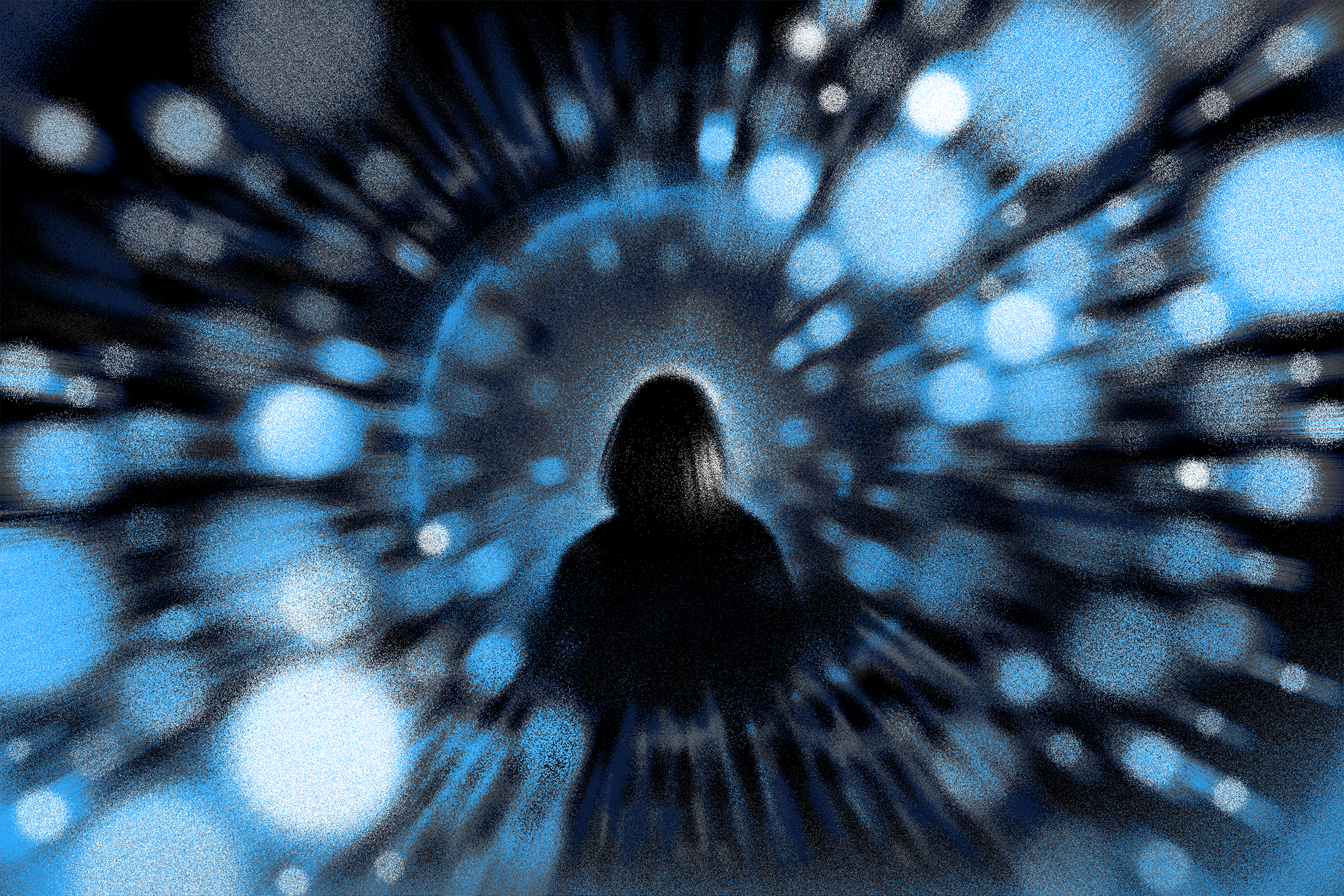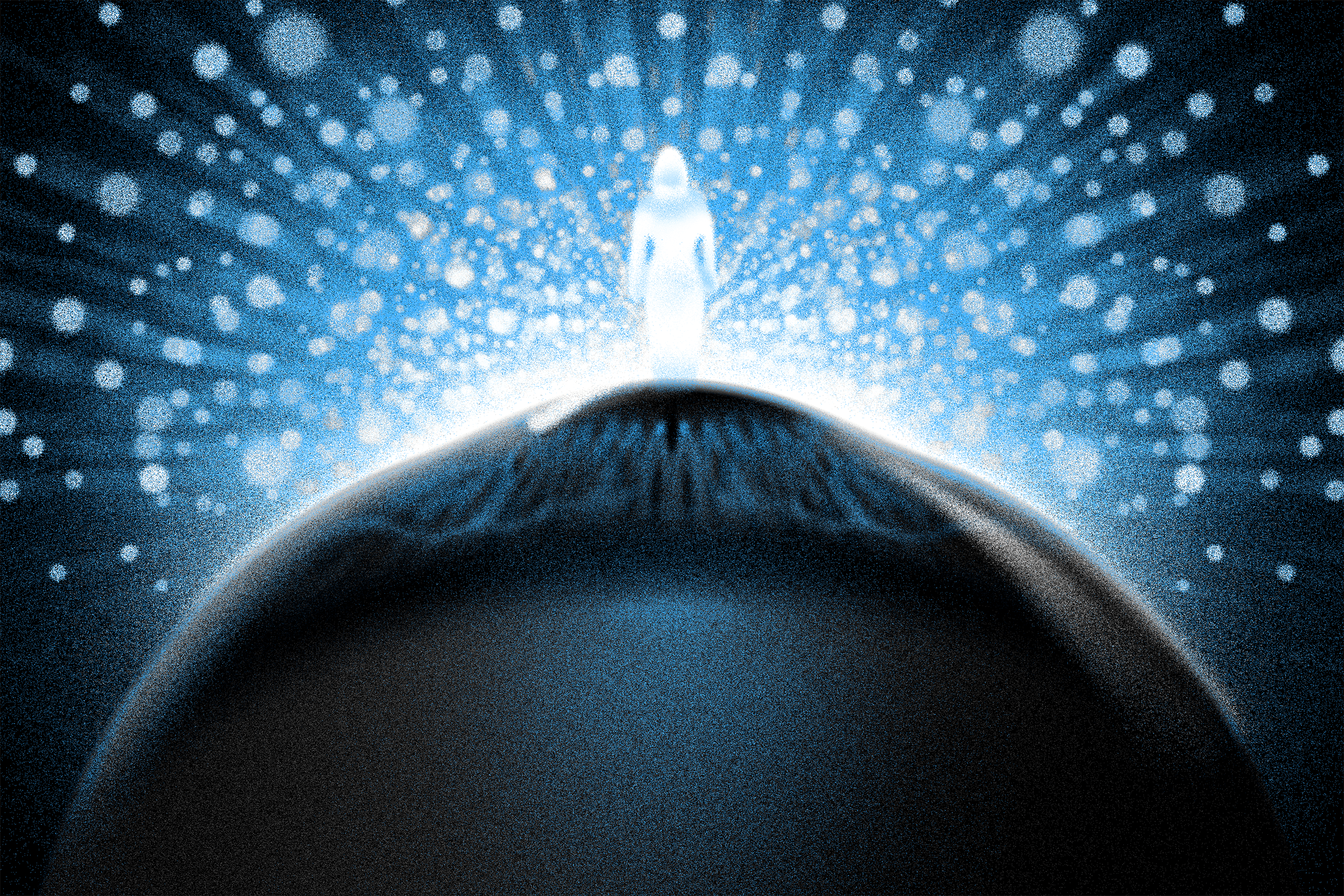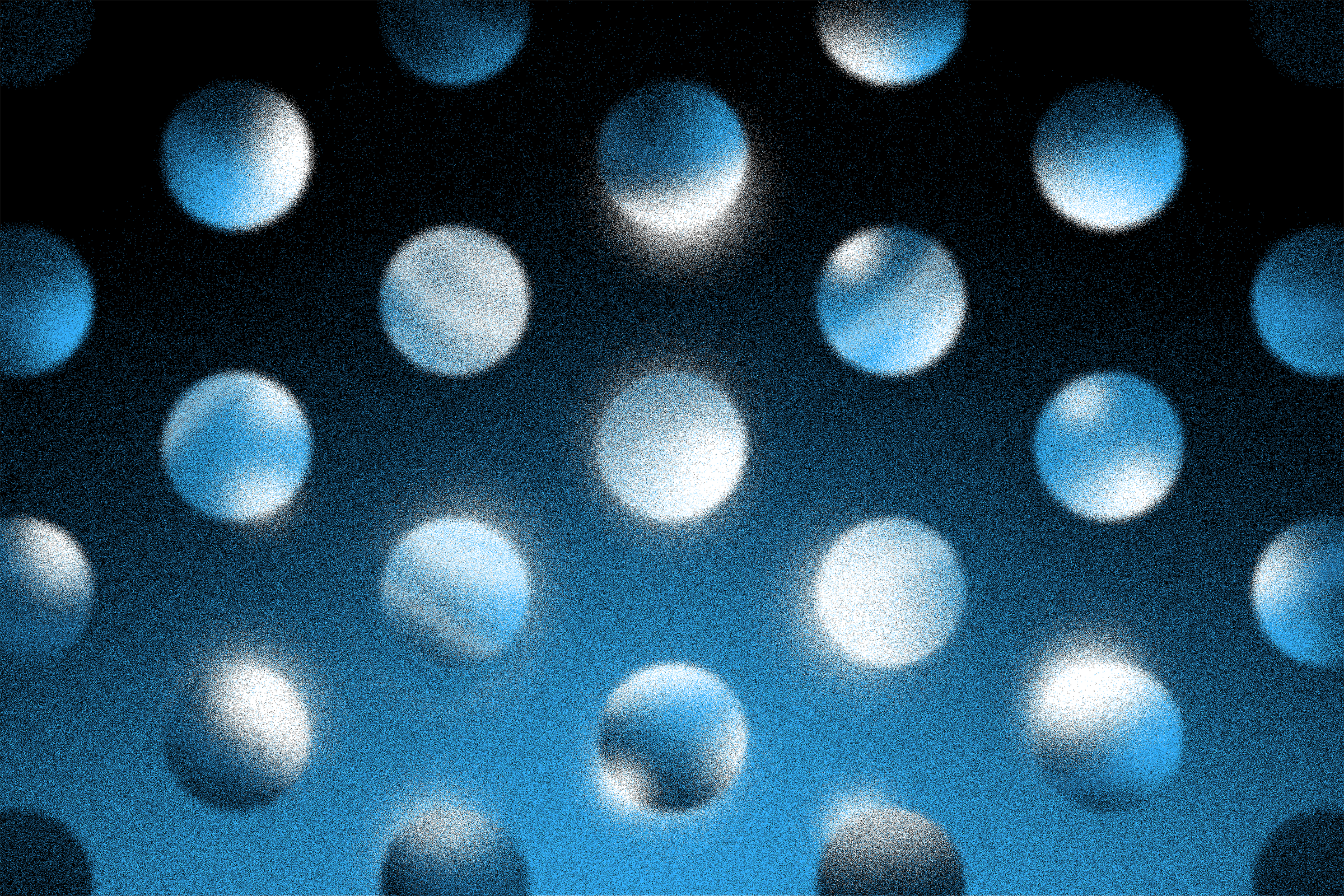
Static Screen
I was an early innovator in the field of hiding in bathrooms. Long before Twitter, long before Candy Crush, I was already whiling away time on the can paging through every Washingtonian or Reader’s Digest or, on one memorable occasion, an infelicitously placed Playboy in a family friend’s guest toilet. Retreating to the restroom served the dual purpose of carving out a break from talking to people and giving me something to read (or, you know, look at).
At school, though, there were no magazines, so I was forced to improvise. If I couldn’t sneak a book into the lavatory, my favorite pastime was to hang the hall pass perpendicular to my face, so I could only see its paper-thin side profile, and then stare at it. In the dim light of the stall, the static would quickly overwhelm the pass so it seemed to disappear. This kept me entertained for ages—I could completely zone out watching fizzy dots engulf the laminated edge.
At the time, I didn’t realize there was anything odd about this. I had never asked anyone if they had the same visual experience—the kind of kid who hides in bathrooms is not going to walk confidently into a conversation that has to start “Hey, does the hall pass disappear if you look at it edge-on?” More to the point, it had never occurred to me to ask. Though I vaguely remember wondering, in early elementary school, whether I was seeing air molecules, by middle school I no longer thought to question the scrim of flickering dots that was always interpolated between me and whatever I was seeing. Though it was occasionally disruptive—especially at night, or when trying to read small or distant text, or when looking at certain patterns that would seem to shiver and crawl—it didn’t occur to me that this wasn’t just the human experience of vision. Without contacts or glasses I could barely see at all; why would this be any weirder?
I assume it crept up on me slowly, like every other awareness of difference, every chilly realization that life will mean translating yourself over and over again.
I can’t quite remember when I first got an inkling that other people see noiseless images, a concept I still don’t really understand—what does that even look like? I assume it crept up on me slowly, like every other awareness of difference, every chilly realization that life will mean translating yourself over and over again. I do distinctly remember the first time I met another person with static vision, which is to say the first time this specific loneliness was lightened. I don’t know how it came up; it was in college, a long time ago. But the revelation that we alone could see—could not not see—what was invisible to others felt like an instant mystical siblinghood. We compared notes on our other idiosyncrasies: we both had self-designed majors, were both fencers, both felt like we never fit in. What could it mean? She drove us out to the woods on her college’s campus and we stumbled around in gleeful night blindness, the sparkling cloud descended over everything, like a stargazing mission nobody else could join.

It figures I was in college when I realized not everyone saw the static. Galaxy-brained questions about subjective experience, like “what if what I call ‘blue’ doesn’t look like blue to you,” are called “dorm-room philosophy” for a reason. Though we supposedly develop theory of mind—the awareness that other people have different knowledge, feelings, and perceptions—around age five, it takes a while to sink in. (A Tumblr called The Dictionary of Obscure Sorrows, which invents words for undefined human experience, once posited that the word “sonder” could mean “the realization that each random passerby is living a life as vivid and complex as your own.” The entry has more than forty-five thousand notes. I feel confident that none of those people are five.) College, being a hotbed of rapid shallow intellectual development, unprecedented density of peers, and drugs, is the perfect crucible for our fledgling theory of mind to start blossoming, mostly by asking the stupidest questions on earth. What if my blue or red or green isn’t everyone’s blue or red or green? What if I’m the only person having real experiences, and everyone else is just going through the motions? What if everyone else is having real experiences and I’m the one faking it? What if some people don’t see static all the time?
These dorm-room conundrums are hackneyed but also profound. The answers don’t matter at all—would it change a single thing if what you call red I call green, as long as we both stop for the same light? At the same time, they also neatly pinpoint the central tension of the modern condition: that we are siloed in the cages of our individual qualia, fundamentally unable to truly understand another person’s experience, no matter how close we seem. Language is at best a stick we can rattle against one another’s bars. It’s one of the best tools we have, but it’s a clumsy one, and at no point does it actually express what it is to think, perceive, exist as someone else; at best, it tells you how another person might describe what they feel.
Nor can science clear this up, at least not science as it currently exists; a brain scan tells you something of the how and why, but the what—what, exactly, is being experienced or perceived?—is lodged inextricably in the perceiving brain itself, accessible only by the language-vexed “self-report.” A friend told me recently that when she went into labor, the nurse asked her to rate her pain on a scale of one to ten, then confided that the rule of thumb is to double the number for women, and for men, to cut it in half. I mention this not to endorse the rule, which seems oversimplified from a gender perspective (surely this has to do with socialization, not biology or identity), but to show how trying to express or even quantify personal experience fails us utterly at the most crucial times. There’s so much of this cursed math.
Anyway, if that sort of thing bothers you, it’s going to bother you. It does not, fortunately, bother me. On the contrary—it makes me downright giddy, inspiring a sort of nihilistic, semi-hysterical delight in the absolute futility of human communication. I said “the tension of the modern condition” because the professional language-users who were stressed out by this idea were mostly modernists, which is to say, people of the early twentieth century. By the time we get to the post- and post-postmodern mindset, the inadequacies of language are enthralling, inspiring, even hilarious. Oh, there are other tensions, but the idea that you can never make your experience truly known? A gas, a riot. Also, for me, a relief.
There’s an episode of the British sci-fi comedy Red Dwarf, my favorite show in my teens, that I found profoundly chilling when I first saw it (and, let’s be honest, still do). In it, lovable dirtbag Lister swaps bodies with his priggish crewmate Rimmer, who technically speaking does not have a body to swap, because he’s dead and exists as a hologram generated from his recorded personality. The idea is that he will use that time to whip Lister’s body into shape, but instead he’s so enraptured by being able to taste and feel again that he wallows in sensual indulgence. When Lister objects, pointing out that he’s welched on the deal, Rimmer lashes out with an insult that cuts right to the heart—because it’s much easier to hit the heart when you’re speaking from inside the body. He starts listing off Lister’s previously private physical imperfections: “Your taste buds are totally clapped out—you’ve killed them stone dead with twenty-five years of nonstop curries. And what about all the aches and pains you never mention? Twinges in your back, crimps in your neck?” Not only is Lister’s dirty laundry on display, but also its contents, and its contents’ contents.
My static is not your static. We’re all in our hazes and darknesses alone.
This was a concept I found terrifying: the idea of that ultimate private domain, the secret of what it feels like to live in your body, being made shared knowledge. (It was outpaced only by the nightmare of Freaky Friday: the same, but with your mom.) Given the choice between being able to literally feel the way someone else feels and being left to fumble with the crude apparatus of words, I know which one I’d pick.
It’s only a hypothetical choice, of course, since we can’t really mind-swap into someone else’s material experience—if that concept is even meaningful, if consciousness can really be neatly unhooked from the particular meat that gave rise to it. More realistically, the choice might be to need to get inside someone else’s skin—that is, to choose to credit only those experiences we convince ourselves we can share—or to make peace with our satellite lives, orbiting one another at a distance but kept apart by the same gravity that connects us. This, too, is a choice between the possible and the impossible, but it’s not clear everyone understands it that way; there’s so much demand, more all the time, for everyone to be fully understandable and fully understood.
I certainly get the allure of feeling like someone is, perhaps for the first time, seeing what you see—of believing that you’re walking inside the same sparkling haze together, at a time when you’re just starting to understand that no one else knows it’s there. Or, on the flip side, at a time when you’re just starting to understand that everyone else is capable of perceiving something you’ve never seen: pure darkness.
But it’s a mirage. My static is not your static. We’re all in our hazes and darknesses alone.

By the time I thought to look my static thing up on the internet, years later, there were forums and a not-quite-official-yet name: visual snow syndrome. Some of the people on the message boards wondered whether the condition was a lingering effect of psychedelic use or viral illness or vaccines. (The psychedelic connection seemed dubious to me. I had experienced visual snow since childhood, long before I’d ever dabbled in psychedelics. And that dabbling was extremely perfunctory, far too little to meaningfully affect my brain. After all, at the doses I was willing to take, there seemed like very little point. Shimmering patterns, trails, strange visual vibrations: I already had that for free.) Some of the people in the forums seemed to be truly suffering, to be scared, to consider themselves disabled by the static crowding out darkness and text and fine lines. As far as I know, we were seeing the same thing, or similar things; we agreed on many of the words and metaphors, paltry as they were: static, snow, dots, noise. But we were certainly not always seeing it the same way.
Now, many years on, there is finally a small but growing body of scholarly work on visual snow. Still, we don’t know very much about it. It happens in the brain, not in the eyes, that part is certain. It is sometimes associated with drug use or head injury, but not always, or most of the time. Apart from the snow, we tend to have other visual symptoms like trails and afterimages, light sensitivity, bad night vision, and floaters. (I have all of these to varying degrees, although the night vision seems like a red herring—of course I have bad night vision, everything is covered in static.) We are more likely to have tinnitus, migraine, and depersonalization and derealization, which again strikes me as tautological. Obviously things will seem less real when they look like a bad photocopy of themselves! My prevailing theory, which is only half unserious, is that reality is a simulation and only we can see the pixels; derealization is, in that case, a logical response.
I suppose there are other ways to communicate your inner life, besides words; still, you wind up with a transmission so imprecise it might just be a brilliant new style.
Some sources say people with visual snow are more likely to have brain fog, depression, and anxiety, but you can find a source to say that about just about anything. Of all the deeply subjective experiences that can’t be measured, compared, quantified, or even accurately described, these (and physical pain) might be the most significant. Everyone probably has them to some degree, or at least everyone worth talking to, and we will never know exactly what they feel like to other people, or how their depression or anxiety or pain stacks up against our own little agonies. How bad on a scale of one to ten? Double that. Cut it in half. Take the tangent. Does what feels like “blues” to me feel like blues to you? Fuck it. There are ultimately only two choices: doubt and nitpick and one-up and purity-test, or choose to accept people’s claims at face value because you’ll never know. What do you have but the glass ball of your senses, and whatever is shouted across the void?

A few weeks ago, I went to the Philadelphia Museum of Art with my mother. Because I was with my mother, I went to see the Impressionists. Lately the static has been quite noticeable, possibly because I had Covid recently, though more likely because while I had Covid I wondered whether it was making the static more noticeable, which made me notice it more. I will not be surprised if we eventually learn that visual snow is simply the inability to ignore irrelevant sensory information, which would also explain the tinnitus. Anyway, this meant the pointillist paintings were genuinely sort of unsettling to look at, layers of vibrating dots over static dots. Water seemed to ripple, trees seemed to bend. For the first time, I wondered: Were they meant to be this way? A relatively realistic pointillist painting does look quite a lot like my regular vision. Did the world look to Georges Seurat the way it looks to me? I suppose there are other ways to communicate your inner life, besides words; still, you wind up with a transmission so imprecise it might just be a brilliant new style.
Then again, it would never occur to me to add the static when painting something, even though I can see it plain as day. More likely it was an act of creative expression, intended not to faithfully transmit the painter’s mundane vision but to shake, in some way, the unknowable vision of the viewer. Just one of our clumsy little waves as we pass one another in the dark, and yet, entirely by chance, that spiritual siblinghood, a moment of connection. What a gift: that in sending our paltry signals to one another from within the locked cages of our own sensoria, we might occasionally, accidentally, get one another exactly right.
Jess Zimmerman is an editor at Quirk Books and the author of Women and Other Monsters.